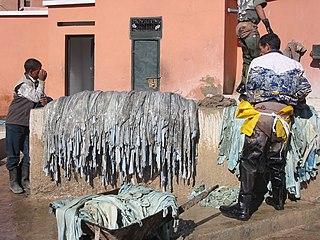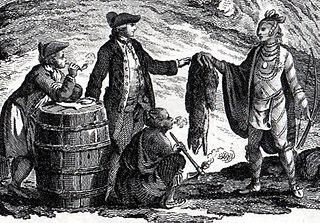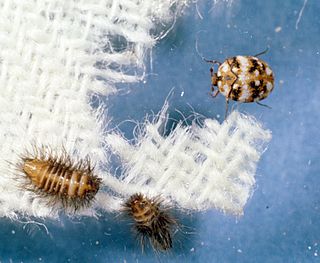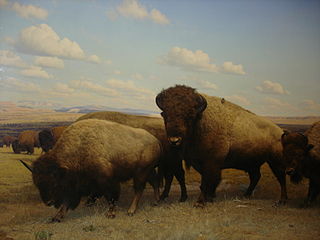
Leather is a strong, flexible and durable material obtained from the tanning, or chemical treatment, of animal skins and hides to prevent decay. The most common leathers come from cattle, sheep, goats, equine animals, buffalo, pigs and hogs, and aquatic animals such as seals and alligators.

Tanning, or hide tanning, is the process of treating skins and hides of animals to produce leather. A tannery is the place where the skins are processed.

Suede is a type of leather with a fuzzy, napped finish, commonly used for jackets, shoes, fabrics, purses, furniture, and other items. The term comes from the French gants de Suède, which literally means "gloves from Sweden". The term was first used by The Oxford English Dictionary in 1884.

Taxidermy is the art of preserving an animal's body by mounting or stuffing, for the purpose of display or study. Animals are often, but not always, portrayed in a lifelike state. The word taxidermy describes the process of preserving the animal, but the word is also used to describe the end product, which are called taxidermy mounts or referred to simply as "taxidermy".
A hide or skin is an animal skin treated for human use. The word "hide" is related to the German word Haut, which means skin. The industry defines hides as "skins" of large animals e.g. cow, buffalo; while skins refer to "skins" of smaller animals: goat, sheep, deer, pig, fish, alligator, snake, etc. Common commercial hides include leather from cattle and other livestock animals, buckskin, alligator skin and snake skin. All are used for shoes, clothes, leather bags, belts, or other fashion accessories. Leather is also used in cars, upholstery, interior decorating, horse tack and harnesses. Skins are sometimes still gathered from hunting and processed at a domestic or artisanal level but most leather making is now industrialized and large-scale. Various tannins are used for this purpose. Hides are also used as processed chews for dogs or other pets.

Wolf hunting is the practice of hunting wolves. Wolves are mainly hunted for sport, for their skins, to protect livestock and, in some rare cases, to protect humans. Wolves have been actively hunted since 8,000 to 10,000 years ago, when they first began to pose a threat to livestock of Neolithic human communities. Historically, the hunting of wolves was a huge capital- and manpower-intensive operation. The threat wolves posed to both livestock and people was considered significant enough to warrant the conscription of whole villages under threat of punishment, despite the disruption of economic activities and reduced taxes. The hunting of gray wolves, while originally actively endorsed in many countries, has become a controversial issue across the globe. Most people see it as cruel, unnecessary and based on misconceptions, while proponents argue that it is vital for the conservation of game herds and as pest control.

Fur clothing is clothing made from the preserved skins of mammals. Fur is one of the oldest forms of clothing and is thought to have been widely used by people for at least 120,000 years. The term 'fur' is often used to refer to a specific item of clothing such as a coat, wrap, or shawl made from the fur of animals.

Sheepskin is the hide of a sheep, sometimes also called lambskin. Unlike common leather, sheepskin is tanned with the fleece intact, as in a pelt.

Nubuck is top-grain leather that has been sanded or buffed on the grain side, or outside, to give a slight nap of short protein fibers, producing a velvet-like surface. It is resistant to wear, and may be white or coloured.

Cowhide is the natural, unbleached skin and hair of a cow. It retains the original coloring of the animal. Cowhides are a product of the food industry from cattle. Cowhide is frequently processed into leather.

The leather manufacturing process is divided into three sub-processes: preparatory stages, tanning and crusting. All true leathers will undergo these sub-processes. A further sub-process, surface coating may be added into the sequence. The list of operations that leathers undergo vary with the type of leather.

The North American fur trade is the (typically) historical commercial trade of furs and other goods in North America, predominantly in the eastern provinces of Canada and the northeastern American colonies. The trade was initiated mainly through French, Dutch and English settlers and explorers in collaboration with various First Nations tribes of the region, such as the Huron and the Iroquois; ultimately, the fur trade's financial and cultural benefits would see the operation quickly expanding coast-to-coast and into more of the continental United States and Alaska.

Taxidermy, or the process of preserving animal skin together with its feathers, fur, or scales, is an art whose existence has been short compared to forms such as painting, sculpture, and music. The word derives from two Greek words: taxis, meaning order, preparation, and arrangement and derma, meaning skin. Directly translated, taxidermy means "skin art."

The tail of the horse and other equines consists of two parts, the dock and the skirt. The dock consists of the muscles and skin covering the coccygeal vertebrae. The term "skirt" refers to the long hairs that fall below the dock. On a horse, long, thick tail hairs begin to grow at the base of the tail, and grow along the top and sides of the dock. In donkeys and other members of Equus asinus, as well as some mules, the zebra and the wild Przewalski's horse, the dock has short hair at the top of the dock, with longer, coarser skirt hairs beginning to grow only toward the bottom of the dock. Hair does not grow at all on the underside of the dock.

Anthrenus flavipes is a species of beetle in the family Dermestidae known by the common name furniture carpet beetle. It has a cosmopolitan distribution, occurring throughout the world, being most active in warmer climates. It is a pest that damages household materials such as textiles.

Yup'ik clothing refers to the traditional Eskimo-style clothing worn by the Yupik people of southwestern Alaska.
The conservation and restoration of fur objects is the preservation and protection of objects made from or containing fur. These pieces can include personal items like fur clothing or objects of cultural heritage that are housed in museums and collections. When dealing with the latter, a conservator-restorer often handles their care, whereas, for the public, professional furriers can be found in many neighborhoods.

The conservation of taxidermy is the ongoing maintenance and preservation of zoological specimens that have been mounted or stuffed for display and study. Taxidermy specimens contain a variety of organic materials, such as fur, bone, feathers, skin, and wood, as well as inorganic materials, such as burlap, glass, and foam. Due to their composite nature, taxidermy specimens require special care and conservation treatments for the different materials.

Leather is created when an animal skin or hide is chemically treated in a process called tanning to preserve them for long term use as material for clothing, handbags, footwear, furniture, sports equipment and tools. Alligator leather is also commonly used to create similar items as mentioned above.

Sinclair Nathaniel Clark was a legendary taxidermy tanner, known throughout that industry for his expertise in tanning animal skins to give them the suppleness that taxidermists require to create lifelike, long-lasting displays. Tanning is the process of treating animal skins and hides for display and preservation. Because tanning is a behind-the-scenes operation of taxidermy, tanners are seldom known outside the industry.



















